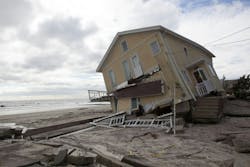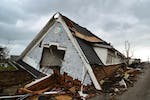Special Section: Catastrophic cases
It didn?t take long for Hurricane Sandy to cut power to Laurence Carolan?s Merrick, N.Y., home, which doubles as the headquarters of House of Laurence, a professional contracting and remodeling company he founded in 1990. Carolan grabbed a few sump pumps, tossed them in a truck, and headed south toward his clients near Long Island?s shore. The storm temporarily disrupted nearby cell phone towers, but Carolan heard about rampant flooding before he lost communication and targeted his patrons closest to the coast.
Carolan reached out to his customers via email days before Sandy slammed the New York metropolitan area, assuring them House of Laurence was prepared and ready to assist them if their homes suffered significant damage and required immediate attention. But like many other upper East Coast contractors, Carolan says he expected the kind of tropical storm common in regions such as Florida, where high winds thrash trees and mangle roofs and render water damage a secondary concern.
As a result, Carolan ensured he had access to tarps and tree-removal services through his participation in the National Association of the Remodeling Industry (NARI) and his connections with large roofing companies; however, those arrangements?and his relatively small pumps?were limited in combating flood waters that carried decks and cars down the street. ?Nobody anticipated the preparation that we would have needed for this,? he says.
HURRICANE SandyType: Category 3 hurricane
Date: October 29, 2012
Damages: $70 billion
Carolan assisted one of his existing clients in removing water from a basement and before long agreed to perform several more cleanup jobs for some of the neighbors. New York state?s first Certified Green Professional estimates he priced three-to-five projects per day for a month following Sandy.
In some cases, a handshake and a modest amount of money upfront to cover wages and ongoing expenses sufficed for emergency repairs. ?This became a very personal thing for me,? Carolan says. If a job extended to the rehab stage, though, it necessitated a contract before the project could proceed, he adds.
Bill Baumann allowed CertaPro Painters to take care of water-damage repairs for three of his four existing clients affected by the storm before he went to give an estimate. The owner of E. Baumann & Son in Totowa, N.J., says he did not take on any new customers following Sandy because he had previously committed to start a residential addition.
After homeowners filed his estimate with their insurance company, it took about three months for the sides to strike a deal, says Baumann, who had to haggle with insurance adjusters in many instances just to reach a favorable compromise.
?Most of the insurance companies didn?t have the right people; they brought people in from the rest of the country,? Baumann says. ?Then about three insurance adjusters later, you?d get a guy from New Jersey who?d come pretty close to your estimate.?
Baumann became wary of the insurance company?s initial pricing because he says the adjuster frequently understates the number and often overlooks key considerations when meshing a home?s renovations with its existing features. When surveying one particular house, for example, Baumann determined that one side of its hip roof needed restored and specified a whole new roof so the shingles of both halves were the same tone and style. But the insurance company didn?t budget for the other side and deemed that a piecemealed roof would satisfy the claim.
In a similar situation, debris from a tree scuffed the side of a client?s home, and the adjuster responded by allocating a single piece of siding to replace the damaged part. Baumann persisted and continually presented photos, measurements, and other documentation until the insurance company in both instances agreed to adjust its estimate for the entire roof and additional siding. In the event the adjuster required even more convincing, Baumann called out a building inspector or town engineer to verify his objections.
?If you wait [the insurance company] out, you can usually come up pretty close to what you were expecting to get for the job,? he says, adding that he is still waiting for insurance payments on two projects he submitted around the beginning of the year.
Baumann discovered an equally frustrating scenario when ordering supplies along the New Jersey shore. Because many contractors and remodelers searched for the same materials concurrently, some suppliers demanded unreasonably high prices for their products. Baumann refused to accept the first quote he received and learned to shop around before making a decision; as a result, he found that suppliers in the north often would deliver down the coast for a nominal fee and still come in cheaper than their counterparts in the south who were gouging prices.
Focusing solely on a handful of existing clients who sought restoration work allowed Baumann to approach what he says is his typical markup on a job?15 percent. Carolan, on the other hand, says he had difficulty securing profit of more than 3 percent despite servicing nearly 25 new customers following Sandy in addition to at least 15 previous clients.
Carolan stuck to Long Island?s Oceanside, Island Park, and Long Beach in the aftermath of the storm in hopes of profiting as close to 10 percent as possible on each job. From his experience working in these areas and studying insurance certificates filed there, Carolan knew the neighborhoods boasted mostly middle- and upper-class households, which were more likely to spend some of their own money if insurance reimbursements did not cover the total cost of their project.
Although he pinpointed areas where his time and effort stood the best chance of being rewarded financially, Carolan says he would be more organized in the event of another weather-related disaster. He would prepare his office staff to create and manage the paperwork quickly and cut down on the number of handshake deals, and he would detail the itinerary of his crews to take advantage of more opportunities and eliminate any confusion.
A better plan of attack could have minimized the small but unexpected changes during each job that ate into the company?s margins. For example, the insurance checks Carolan received listed both the homeowner and mortgage company, meaning he had to make sure the mortgage company possessed all relevant documentation before he could cash the check; then, once he arrived at the bank, an associate told him the homeowner must come and verify the signature on the check.
Carolan suffered this setback a few times before he lobbied the bank to accept a photocopy of the homeowner?s driver?s license. He succeeded and began collecting one at the onset of each project. Carolan also copied every document, even emails, to avoid delays if the mortgage company failed to receive paperwork or misplaced a piece of information.
In the future, Carolan also would provide checklists to homeowners in anticipation of a storm and offer them services ranging from on-call support to assistance in moving possessions from their basements beforehand. That kind of personal attention can really set a business apart, he says.
?I would also stock up on candy and tissues,? Carolan continues. ?Candy for the kids when you go out to see them, and tissues for the ladies who cried on my shoulder about the irreplaceable family photographs and other invaluable possessions that were lost.?
Moore, Okla.
After a catastrophic tornado struck Moore, Okla., in 1999 and again in 2003, Marvin Haworth preferred the insurance company visit his clients first and assess the damage to their houses. The owner of Marvin Haworth Homes in Moore found the resulting report legitimate and worked off the adjuster?s estimate to complete the rebuild and turn a reasonable profit.
Following the most recent twister, however, Haworth says the insurance company has been doling out diminishing estimates that make it extremely difficult for builders and remodelers to perform quality work and earn enough revenue to keep their bottom line. The abrupt change in how adjusters price jobs pressures homeowners to accept the insurance company?s abject bid and then burdens them with hiring a contractor who is willing to labor within uncomfortably tight margins, he adds.
?They?ve got to try to find somebody who will fix their house for half of what it takes or less,? says Haworth, who has been trading estimates on some of his renovation projects with the insurance company for four-to-five weeks.
Moore TornadoType: EF-5 tornado
Date: May 20, 2013
Damages: $2 billion
Haworth has yet to strike a deal with the insurance company for any of the five houses he plans to repair and doesn?t know how long it will take to reach an agreement on any of them. On the other hand, the insurance company has signed off on all 15 of the homes that Marvin Haworth Homes will strip down to the sheetrock and build up from the ground.
Haworth says he prefers these rebuilds because repairing a home that relies on an old foundation becomes even more expensive than constructing an entirely new house. In some instances, though, the insurance company has pushed to renovate a home despite third-party assessments that advise the opposite course.
?It?s just not prudent to spend the kind of money you?re spending to repair some of these structures, and to do that on top of a slab that?s 35 years old,? Haworth says. ?I have one client who has probably no less than four reports indicating that his house is a total loss--and the insurance company wants to fix it.?
The adjuster for one of the five repair jobs has reviewed Haworth?s estimate and sent it to his corporate office, but Haworth says he hasn?t received a response. The adjuster priced the job at $48,000, but Haworth estimated it would cost about $150,000 to fix the $250,000 home, he adds.
Based on his experience in these situations, Haworth says he never relies on insurance pricing and always conducts his own estimate. At the very least, he diligently reviews each insurance bid because different companies use different methods, and the manner in which they list items can be confusing. Making sure the work can be completed for what the insurance company estimates remains the primary consideration for a remodeler, Haworth says.
At one site, the storm had dislodged a home?s roof and saturated some of the insulation underneath. The adjuster concluded Haworth didn?t need to take out all of it, just the parts that were wet. Haworth disagreed and argued that all of the insulation should be removed because it would be nearly impossible to determine which portions had been soaked. ?How do you know which is wet and which isn?t? The whole roof was gone,? he says.
The insurance company budgets 30 cents per every square foot of insulation that must be pulled out, but the true cost adds up to more than that, Haworth says. The task requires a vacuum to extract the insulation, for example, and a 40-yard Dumpster in which to properly discard it. These items don?t factor into the adjuster?s estimate and ultimately destroy any kind of revenue for the remodeler, Haworth says. ?If you agree to do it for what they?ve offered, you?re going to lose money,? he adds.
Haworth shoots for 20 percent more than the adjuster?s final estimate so that he can pay his office and job-site help and still hit what the insurance industry deems a standard profit margin?10 percent. Although none of his projects have been completed, Haworth says he is optimistic the firm can reach 10 percent in the jobs it has taken on since the most recent tornado ripped through Moore.
On the other end, Donn Lipscomb says he doesn?t have any direct interaction with the insurance company and advises homeowners to bring out an adjuster before doing anything else. Once the insurance company contacts its corporate office, then the owner of Moore?s Roofing & Insulation in Oklahoma City says he will come out and bid the job.
?That stops me from wasting a lot of time and a lot of trips,? says Lipscomb, who initially stuck with only previous customers who called about repairs. ?We know them and we know that they?re not going to be wasting our time.?
Lipscomb eventually expanded his business range to include referrals from past clients because he knew there was a good chance those people would hire his company. Many roofers will travel to a house, survey the roof, then tell the homeowner they will follow up soon, even if they have no interest in that particular job, says Lipscomb, who always leaves an estimate and information on the first trip if he has any interest in the project.
If a potential customer sought temporary repairs following the twister, Moore?s often went out and secured tarps to the roof. In those cases, Lipscomb estimates his company was rewarded the job about 80 percent of the time. Once Moore?s entered into a contract with the homeowner, Lipscomb created a card for the work and placed it at the end of the line. When the company finished a job, it removed that card from the lineup and moved up the remaining ones.
?We always stay with the one we?ve started and don?t move on until we?re finished,? Lipscomb says.
Some of his customers told him they saw people working on a roof across the street one day for an hour or so only to leave and come back a few days later. By ?spiking? as many roofs possible, these companies lock in too many jobs and often must ask for money upfront to cover labor and material costs for the last roof they started, says Lipscomb, who cautions doing business like these contractors because they don?t have enough operating capital to pay for unexpected changes and repairs.
Moore?s has enough credit with its suppliers that it can remain solvent after damaging storms and doesn?t need any upfront payment, Lipscomb says. ?I could get $100,000 worth of material in a month, and I don?t have to pay for it until the end of the month,? he adds.
This disciplined approach keeps Lipscomb aware of the workload at all times and ensures he doesn?t overextend the company?s resources. ?It?s hard to turn down work, but when you?ve got enough, you?ve got to quit selling,? he says.
If Lipscomb notices the company is running behind, he makes sure he keeps his clients in the loop. ?If you can?t [stay on schedule] make sure that you keep the customer informed,? he says. ?Sometimes all people need is a phone call.?
Joplin, Mo.
Like many other local contractors, CD Beaver received numerous calls after a calamitous tornado ravaged Joplin, Mo. The owner of Generations Construction, a remodeling and new-construction company in Joplin, says he didn?t want to expand his business following the storm and then immediately have to scale back down once work inquiries inevitably tapered off.
?Mostly we stuck with people who were either former clients or referred to us from former clients,? Beaver says. ?We just tried to make sure to only take on what we could handle.?
Beaver estimates his firm committed to do about 12 jobs in wake of the twister. In one instance, Generations built a new house for a woman who lost her home in the storm and, in another case, remodeled 85 percent of an existing house purchased by a man whose original home had also succumbed to the twister. The remaining projects, however, came down to insurance restoration.
JOPLIN TornadoType: EF-5 tornado
Date: May 22, 2011
Damages: $2.8 billion
If a potential client contacted Generations and needed help with temporary repairs before the insurance company could come out and assess the damage, Beaver and his crew covered the roof with tarps and did as much as they could to buy time.
?We just tried to do what we could to protect the property until the adjuster got there,? Beaver says.
In some areas, the loss of electricity made it difficult to run water pumps and other machinery so that a home could dry out in preparation for restoration work; furthermore, CertaPro was pulling equipment from its branches around the state and across the country in response to the demand in Joplin, limiting what was available for everyone else, Beaver says.
Generations waited to give an estimate on a job until the insurance company filed its paperwork. Beaver didn?t encounter many problems with the adjuster?s pricing because the homeowner dealt directly with the insurance company most of the time; however, when an issue about what exactly needed to be done with a house arose, Generations met with the adjuster and repeatedly sent documentation to the insurance company until the matter was resolved, he says.
During one project, Beaver noticed the seals between the home?s double-pane windows were broken, causing the windows to fog up frequently. Generations lobbied the insurance company for six months and presented photos showing the compromised seals and resulting condensation.
?We were just finishing up the project before they finally approved replacing all of the windows in the house,? Beaver says.
By and large, Generations managed to stay within its margins and complete each job for the cost the insurance company estimated, Beaver says. After overhead and other expenses, the firm typically finished with a profit of 10 percent, which fell in line with the adjuster?s projections.
If unbudgeted costs came up during a project, Beaver filed supplements, which he compared to change orders. The insurance company would review any supplements and then reimburse the expenses to the firm or the homeowner. For the most part, however, Generations and the insurance company collaborated well to formulate a realistic plan, Beaver says.
At its core, operating a remodeling business in the aftermath of a considerable storm is no different than running it any other day of the week, Beaver says. Downed utilities, increased sales traffic, and simultaneous demand for materials can be challenging, but as long as a company stays within its footprint and knows it margins, it should be able to take care of its clients and make money regardless. PR




